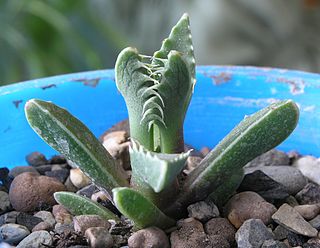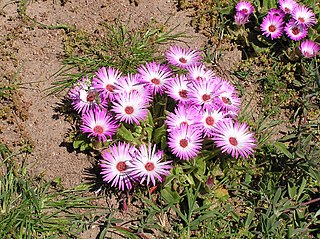
The Asclepiadoideae are a subfamily of plants in the family Apocynaceae. Formerly, they were treated as a separate family under the name Asclepiadaceae, e.g. by APG II, and known as the milkweed family.

The Aizoaceae, or fig-marigold family, is a large family of dicotyledonous flowering plants containing 135 genera and about 1800 species. They are commonly known as ice plants or carpet weeds. They are often called vygies in South Africa and New Zealand. Highly succulent species that resemble stones are sometimes called mesembs.

Lampranthus is a genus of succulent plants in the family Aizoaceae, indigenous to southern Africa.

Mesembryanthemum is a genus of flowering plants in the family Aizoaceae, indigenous to southern Africa. As with many members of that family, it is characterized by long-lasting flower heads. Flowers of Mesembryanthemum protect their gametes from night-time dews or frosts but open in sunlight. There is an obvious evolutionary advantage to doing this; where sun, dew, frost, wind or predators are likely to damage exposed reproductive organs, closing may be advantageous during times when flowers are unlikely to attract pollinators.
Aptenia was a small genus of flowering plants in the family Aizoaceae, which as of January 2024 was treated as a synonym of the genus Mesembryanthemum. Species formerly placed in the genus are native to southern Africa. The genus name is from the Greek a- (not) and ptenos (winged), and refers to the wingless fruit capsules.

Cephalophyllum is a genus of plants in the family Aizoaceae.

Drosanthemum ("dewflowers") is a genus of succulent plants in the ice plant family native to the winter-rainfall regions of southern Africa, including Namibia and the Cape Provinces and Free State of South Africa. Most species bear colorful flowers.

Faucaria is a genus of around 8 species of succulent subtropical flowering plants of the family Aizoaceae. The name comes from the Latin word fauces because of the appearance of "teeth" on the leaves.

Cleretum is a genus of flowering plants in the family Aizoaceae, native to the Cape Provinces of South Africa.
Tanquana is a genus of flowering plants belonging to the family Aizoaceae.

Pleiospilos compactus, called living rock, is a species of flowering plant in the ice plant genus Pleiospilos, native to the southwestern Cape Provinces of South Africa. A succulent, it has gained the Royal Horticultural Society's Award of Garden Merit.
Bergeranthus is a genus of flowering plants belonging to the family Aizoaceae.
Cylindrophyllum is a genus of flowering plants belonging to the family Aizoaceae.
Esterhuysenia is a genus of flowering plants belonging to the family Aizoaceae.
Hereroa is a genus of flowering plants belonging to the family Aizoaceae.
Leipoldtia is a genus of flowering plants belonging to the family Aizoaceae.

Nananthus is a genus of flowering plants belonging to the family Aizoaceae.

Schlechteranthus is a genus of flowering plants belonging to the family Aizoaceae.











